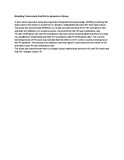| dc.description.abstract | A time series approach using autoregressive integrated moving average (ARIMA) modeling has
been used in this study to model the co-dynamic relationship between HIV and Tuberculosis.
The study has showed that ARIMA(0,1,2) model provides the best fit for HIV prevalence rate
and that the ARIMA(1,2,0) model provides the best fit for the TB case notification rate.
TB case notification rate and HIV prevalence rate time series demonstrated that there is a long
run equilibrium relationship between HIV prevalence and TB notification rates. The current
declining trends of TB cases may indicate that the efforts in HIV control could be driving down
the TB epidemic. The Kenyan twin epidemic has time lag of 6 years between the trends of HIV
prevalence and TB case notification rate.
The study also showed that there is Granger causal relationship between HIV and TB trends and
that HIV Granger causes TB. | en |


